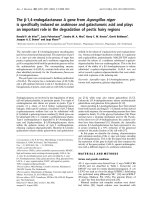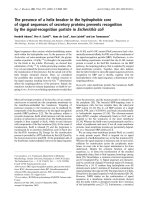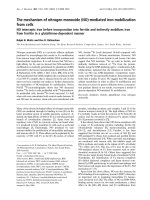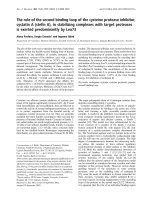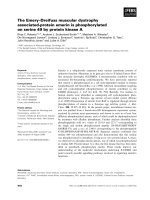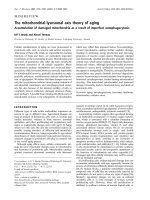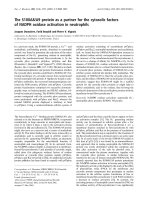Báo cáo y học: "The Difficult-to-Control Asthmatic: A Systematic Approach" doc
Bạn đang xem bản rút gọn của tài liệu. Xem và tải ngay bản đầy đủ của tài liệu tại đây (64.65 KB, 8 trang )
109
Incorrect Diagnosis
It is important to remember that “all that wheezes
is not asthma” (Table 1). When there is a lack of
response to standard therapy, the diagnosis of
asthma should be questioned and revisited. Obtain-
ing pulmonary function testing with flow/volume
curves (both inspiratory and expiratory) and doc-
umenting reversible airway obstruction or airway
hyperresponsiveness become essential. A flat-
tened inspiratory curve, for example, is indicative
of upper airway obstruction (ie, vocal cord dys-
function). A methacholine challenge should be
performed when there is a question of airway
hyperresponsiveness. Normal test results will
point away from asthma and lead to a search for
other causes of respiratory difficulty. Hyperven-
tilation and vocal cord dysfunction are two frequent
masquerades and complicating factors of asthma
and are discussed in more detail below. Noctur-
nal dyspnea can be an indication of uncontrolled
asthma; although it can also exist in congestive
heart failure or chronic obstructive pulmonary
disease (COPD). Obstructive sleep apnea, although
mainly giving rise to symptoms at night, is usu-
ally not dyspneic. The presence of nocturnal dys-
pnea, with or without cough, especially in the set-
ting of cardiac dysfunction or coronary artery
disease, should raise the concern for the presence
of cardiac asthma. A long-time smoker with irre-
versible airflow obstruction can have underlying
Review Article
The Difficult-to-Control Asthmatic: A
Systematic Approach
Annie V. Le, MD; Ronald A. Simon, MD
Abstract
With the judicious use of inhaled corticosteroids, 
2
agonists, and leukotriene modifiers, most patients
with asthma are easily controlled and managed. However, approximately 5% of asthmatics do not
respond to standard therapy and are classified as “difficult to control.”
1
Typically, these are patients who
complain of symptoms interfering with daily living despite long-term treatment with inhaled corticosteroids
in doses up to 2,000 g daily. Many factors can contribute to poor response to conventional therapy,
and especially for these patients, a systematic approach is needed to identify the underlying causes.
First, the diagnosis of asthma and adherence to the medication regimen should be confirmed. Next, poten-
tial persisting exacerbating triggers need to be identified and addressed. Concomitant disorders should
be discovered and treated. Lastly, the impact and implications of socioeconomic and psychological fac-
tors on disease control can be significant and should be acknowledged and discussed with the individ-
ual patient. Less conventional and novel strategies for treating corticosteroid-resistant asthma do exist.
However, their use is based on small studies that do not meet evidence-based criteria; therefore, it is
essential to sort through and address the above issues before reverting to other therapy.
A.V. Le, R.A. Simon—Division of Allergy, Asthma, and
Immunology, The Scripps Clinic and the Scripps Research
Institute, La Jolla, CA
Correspondence to: R.A. Simon, MD, Division of Allergy,
Asthma, and Immunology, The Scripps Clinic and the
Scripps Research Institute, 10666 North Torrey Pines
Road, W205, La Jolla, CA 92037; E-mail:
;
DOI 10.2310/7480.2006.00013
110 Allergy, Asthma, and Clinical Immunology / Volume 2, Number 3, Fall 2006
COPD. Making the diagnosis between COPD and
asthma may be difficult as the two can have sig-
nificant overlapping clinical characteristics. COPD
typically shows a generally progressive airflow
obstruction, with or without airway hyperreac-
tivity, and typically is irreversible or only poorly
reversible. The distinction is important in tailor-
ing therapy with the use of anticholinergics and a
greater emphasis on health maintenance and reha-
bilitation for patients with COPD.
2,3
A restrictive
pattern on pulmonary function tests should lead to
a search for causes of restrictive lung disease. A
careful history and physical examination may
raise the suspicion of upper airway obstruction
manifested classically as stridor. In a child with
wheezing, the diagnosis of cystic fibrosis should
always be on the differential, especially in the
setting of failure to thrive or persistent diarrhea.
Localized obstruction of a major airway arising
from endobronchial lesions is a rare but potential
cause of wheezing.
Hyperventilation
Symptoms of hyperventilation often go unrecog-
nized and may frequently be attributed to asthma.
In a study of 14 “pseudosteroid-resistant” asth-
matics, half were found to have hyperventilation as
a potential cause of their disease.
4
These patients typ-
ically note subjective dyspnea without any pro-
voking triggers. Their difficulty often is with inhal-
ing. They may complain that they “can’t get a good
breath” or “can’t breathe” without any objective
signs of respiratory distress. Although a metha-
choline challenge will invariably be negative, some
may note a subjective response to rescue metred-
dose inhalers (MDIs) as proper inhalation tech-
niques will slow the respiratory rate. For these
patients, it may be beneficial to monitor peak expi-
ratory flow rate (PEFR) before and after hyper-
ventilation episodes to make patients aware of their
breathing, and to retrain their breathing pattern.
5
Vocal Cord Dysfunction
Vocal cord dysfunction (VCD) may be seen alone
or accompanying asthma and may masquerade as
mild or severe asthma. Some patients with VCD
may be on aggressive medical regimens, includ-
ing oral corticosteroids and immunosuppressive
therapy, and may even be classified as having
corticosteroid-resistant asthma.
6
Typically, patients
complain of feeling “tight” but point to their
throat, and for them, inhaling is more difficult than
exhaling. These patients can quickly and unex-
pectedly go from well to severely ill, some fol-
lowing an irritant exposure but for most without
any obvious trigger.
7
The attack is not necessar-
ily trivial as there can be accompanying oxygen
desaturation. On auscultation, wheezing is loud-
est over the larynx. Although an inspiratory cut-
off on the flow volume loop is characteristic of
VCD, the diagnosis is best made by direct visu-
alization of the vocal cords, which, during an
acute attack, will show paradoxical movement dur-
ing inspiration.
8
VCD may or may not be a form
of conversion disorder but has been found to fol-
low physical or psychological trauma.
9
Physi-
cian awareness and patient awareness are keys to
successful treatment that involves speech and
psychotherapy.
Poor Adherence
Once the diagnosis of asthma is made, it is impor-
tant to ensure adherence to the medication regi-
men and document the correct use of inhalers.
For “difficult asthmatics,” this is particularly nec-
essary because, although counterintuitive, asth-
matics who are more ill are actually less likely to
Table 1 Alternate Diagnoses to Consider in
Difficult-to-Control Asthmatic Patients
Hyperventilation
Vocal cord dysfunction
Cardiac asthma/congestive heart failure
Chronic obstructive pulmonary disease
Gastroesophageal/supraesophageal reflux disease
Restrictive lung disease
Sleep apnea
Cystic fibrosis
Endobronchial lesions
The Difficult-to-Control Asthmatic — Le and Simon 111
take their medicines.
10
Despite our best efforts, poor
adherence is surprisingly still common, and even
more so with MDIs compared with oral medica-
tions, with some studies documenting between
10 and 46% adherence.
11
The adolescent popula-
tion in particular is notorious for noncompliance,
some of the reasons being forgetfulness, denial,
embarrassment, inconvenience, fear of side effects,
a lack of efficacy of medicines, and laziness.
12
Even
when patients are compliant, use of improper
inhaler techniques may prevent appropriate deliv-
ery of the drug. Therefore, a patient demonstration
of proper techniques should be part of every physi-
cian visit.
Exacerbating Factors
For difficult-to-control asthmatics who have ongo-
ing exposure to allergens or other triggers, iden-
tifying and eliminating these may help with asthma
management. Microbial volatile organic com-
pounds released from excess indoor mould growth
and water-intruded areas are increasingly being rec-
ognized as important irritants triggering asthma.
13
Although dust mite control measures are rela-
tively easy to implement for those with dust mite
allergy, noncompliance remains an important
obstacle. Cost may become an issue for some
families as environmental control measures are not
covered by insurance companies.
14
Removing or
just keeping the house cat away from the bedroom
is easy advice, but, apparently, too often it is not
followed. Patients with a history of asthma that
improves on weekends or holidays should raise the
concern for exposure to occupational allergens
or irritants. For these, serial PEFR measurements
and specific challenge testing may need to be per-
formed to institute appropriate avoidance measures
or, when necessary, removal from the workplace.
A drug history is always important to gather in a
difficult asthmatic as such well-known and exten-
sively used drugs such as nonsteroidal anti-inflam-
matory drugs (NSAIDs) and
-blockers can be sig-
nificant unidentified precipitators of
life-threatening asthma.
15
One should keep in
mind that aspirin and NSAIDS are in many over-
the-counter cold remedies and are often over-
looked. A simple question such as “What do you
think causes your asthma?” may tease this out. Fur-
thermore, identifying the aspirin-sensitive indi-
vidual with aspirin-exacerbated respiratory disease
or aspirin triad will help guide therapy (ie, aspirin
desensitization).
16
Dietary additives have been
reported to cause wheezing, although this is still
subject to debate.
17
Concomitant Disorders
Certain disorders that tend to accompany and
exacerbate asthma should be kept in mind in dif-
ficult-to-control patients (Table 2).
Gastroesophageal Reflux
Disease/Supraesophageal Reflux Disease
Gastroesophageal reflux disease (GERD) is more
common in patients with asthma, with an esti-
mated prevalence of 34 to 80%.
18
However, the
diagnosis of GERD/supraesophageal reflux disease
(SERD) is not always clear-cut. In one study, 40
to 60% of asthmatics, 57 to 94% of those with oto-
larynogologic symptoms and 43 to 75% with
cough were shown to have SERD without classic
reflux symptoms.
19
To make the diagnosis, a 24-
hour pH monitoring dual-probe study can corre-
late episodes of reflux with cough or other symp-
toms of asthma. Although a negative study can
exclude acid-related symptoms, a positive study
does not necessarily guarantee the success of acid
suppression therapy. Often a therapeutic trial of
Table 2 Concomitant Disorders that May Be
Present in Asthmatic Patients
Gastroesophageal/supraesophageal reflux disease
Allergic rhinitis
Chronic rhinosinusitis
Hyperventilation
Endocrinopathies (eg, hyperthyroidism, carcinoid
syndrome)
Allergic bronchopulmonary aspergillosis
Aspirin-exacerbated respiratory disease
Churg-Strauss syndrome/other vasculitides
medical therapy for GERD may be both diagnos-
tic and therapeutic, with testing reserved for more
uncertain or recalcitrant cases. Twice-daily proton
pump inhibitors have been shown to have some
therapeutic success, but it may take several weeks
before an improvement in symptoms is noted.
20
Furthermore, lifestyle changes consisting of ele-
vating the head of the bed, waiting at least 2 hours
between dinner and bedtime, and eating smaller
and more frequent meals with reduction or elim-
ination of substances that can exacerbate reflux (eg,
alcohol, caffeine, nicotine), in addition to weight
loss, are strongly recommended.
It is important to mention that hyperventila-
tion and other forms of dysfunctional breathing
may exist concomitantly with asthma, although the
prevalence for this is unclear.
21
Teasing this out can
be a challenge, and tailoring therapy will likely be
even more difficult. Recognizing the coexistence
of dysfunctional breathing, however, can help
prevent unnecessary step-up of asthma therapy.
Other Diseases
There is increasing evidence that the upper and
lower airways represent “one continuous airway,”
in which a pathologic process affecting one can
affect the other. Therefore, uncontrolled allergic
rhinitis or chronic rhinosinusitis can affect asthma
control. Treatment of allergic rhinitis with nasal
corticosteroids, for example, has been shown to
improve symptoms of asthma and airway hyper-
responsiveness.
22
Identifying and managing upper
respiratory inflammation is therefore important,
especially in the group of difficult-to-control asth-
matics. Endocrinopathies such as hyperthyroidism
or hypocorticalism and carcinoid syndrome may
lead to exacerbations and will need to be con-
comitantly treated. An elevated immunoglobulin
E level in a persistent asthmatic with evidence of
centrilobular bronchiectasis should lead to a full
evaluation for allergic bronchopulmonary
aspergillosis. Patients with Churg-Strauss vas-
culitis may also have particularly severe and dif-
ficult-to-manage asthma, the presence of which
should be suspected in the setting of serum
eosinophilia or a mononeuritis multiplex.
Socioeconomic Factors
When there is no obvious medical reason for
refractory asthma, socioeconomic factors must
be taken into account (Table 3). These include
issues of poverty and race, access to medical care,
adherence, psychosocial issues, and environmen-
tal risk factors. These particularly apply to the
inner-city population of children and young adults,
which has seen the greatest increase in the preva-
lence and severity of asthma in the past 20 years.
23
Poverty appears to underlie other socioeconomic
risk factors. The specific role that race plays is less
certain and harder to tease apart. Poverty influences
access to medical care, which has been associated
with increased hospitalizations and emergency
department visits.
24
For many of the urban poor,
the closest emergency room becomes the only
access to medical care. This is compounded by the
closing of many inner-city hospitals in recent
years owing to inadequate funds. For those attempt-
ing to access the proper services, barriers may
include a lack of transportation or child care, a lack
of available after-work clinic hours, or an inabil-
ity to communicate in English.
25
Obvious problems
arise when the emergency room becomes the pri-
mary access to care. Adherence to scheduled fol-
low-up visits and to medications can be affected,
influencing the quality of care. For a population
112 Allergy, Asthma, and Clinical Immunology / Volume 2, Number 3, Fall 2006
Table 3 Potential Contributing Socioeconomic
and Psychological Factors in the
Difficult-to-Control Asthmatic
Socioeconomic risk factors
Poverty
Race
Access to medical care
Adherence
Psychosocial issues (eg, crime, violence,
unemployment)
Environment (indoor and outdoor allergens and
irritants, eg, tobacco smoke, NO
2
)
Differing cultural practices
Psychological factors
Negative emotions
Functional symptoms
Anxiety/panic disorders
Depression
especially in need of adequate asthma control,
studies have surprisingly shown that there is an
overall low rate of prescribing of controller (37%)
and relief (61%) medications.
26
Additionally, the
likelihood of a scheduled visit with an established
care provider (25%), of the use of controller med-
ications (24%), and of the correct use of oral
(44%) and inhaler (27%) medicines is also dra-
matically low.
27
The problem is compounded by
the unfortunate reality that many of the poor can-
not afford medicines, much less expensive ones.
The psychosocial risk factors that exist in cer-
tain neighbourhoods can have a large impact on
asthma care. Stresses arising from crime, vio-
lence, drugs, gangs, and unemployment take time,
energy, and focus away from appropriately caring
for a child with asthma. Families are often headed
by single women who balance work, child care,
and other issues of daily living. Multiple caretakers
may exist for these children, making effective
communication and education particularly diffi-
cult and challenging. Furthermore, aggression,
anxiety, and depression can be important issues in
difficult living conditions and have been found to
be risk factors for childhood asthma mortality.
28
Differing cultural practices can also represent bar-
riers to effective care as certain individuals may
choose to follow folk remedies for cures or to
search other “healers” instead of seeking or com-
plying with standard Western medical care.
Adherence can be a problem in any popula-
tion, but additional barriers can exist for socioe-
conomically disadvantaged asthmatics. A lack of
education or understanding of English, low house-
hold income, racial or ethnic minority status, and
poor patient/physician communication are all fac-
tors associated with poor adherence.
29
Besides
adherence to medications, avoidance of triggers in
this population also proves to be difficult. A study
of inner-city children showed that only one-third
were able to avoid known asthma triggers most of
the time and about two-thirds could not prevent
exposure to cigarette smoke.
30
Lastly, among socioeconomic factors, envi-
ronmental exposure is also a major risk. The sub-
standard housing that many of these patients live
in contains high levels of indoor allergens, such
as dust mite, mold, cockroach, and rodents, that
are difficult to avoid and exterminate. Addition-
ally, there can be exposure to tobacco smoke,
volatile organic compounds, and nitrogen dioxide
in the home. In highly polluted and industrial
environments, limiting outdoor exposure to chem-
icals such as sulphur dioxide and ozone can be par-
ticularly difficult.
31
Although the barriers against effective asthma
care appear to be insurmountable in the socioe-
conomically disadvantaged population, it appears
that, especially in this group, education is an
important step in achieving better asthma con-
trol. A recent review of programs that have
attempted to reduce the number of emergency
department visits and hospitalizations in African
American and Hispanic patients found that suc-
cessful programs have incorporated intensive and
repetitive patient education regarding asthma as
an inflammatory airway disease, environmental
control, controller versus “quick relievers,” pre-
vention of exercise-induced asthma, written action
plans for acute exacerbations, and demonstrating
proper techniques for using inhaler devices.
32
In
addition, education by a nurse or pharmacist advo-
cate, with time allotted for individual instruction,
can be especially effective.
Psychological Factors
Existing psychological issues in a patient may
make asthma particularly difficult to treat (see
Table 3). Negative emotions, for whatever reason,
even in normal patients, can influence the symp-
toms and management of asthma and should be
recognized and addressed. When patients present
with atypical symptoms or do not respond prop-
erly to medications, functional symptoms should
be suspected. Psychiatric analysis may help deter-
mine this. In patients with comorbid asthma and
anxiety disorders, treatment should be geared at
controlling the asthma as asthma and sudden exac-
erbations are likely to cause anxiety and panic-like
symptoms in the first place. Asthmatics with
comorbid depression are especially difficult to
treat. For this population, it is important and nec-
essary to address and treat the depression before
there can be any success with asthma therapy.
33
The Difficult-to-Control Asthmatic — Le and Simon 113
Other Issues
A few other categories of difficult-to-control
asthma deserve brief mention. Premenstrual wors-
ening of asthma can occur in some females and is
typically poorly responsive to glucocorticoids but
may respond to aggressive hormonal therapy.
34
Nocturnal worsening of asthma may persist in
some individuals despite maximal doses of corti-
costeroids, necessitating more aggressive inter-
ventions. Brittle asthma can be extremely unsta-
ble, may be related to a lack of perception of
symptoms and disease severity, may involve
unidentified triggers, and therefore may respond
only to individualized therapy.
35
Patients with
“steroid-dependent asthma” can often be found on
a “roller-coaster” pattern of recurring bursts of cor-
ticosteroid therapy, and for these, treating exac-
erbations long enough and with high-enough doses
of steroids may be needed to achieve long-lasting
effects. Steroid-resistant asthmatics are defined as
those patients with persistent obstruction (< 15%
improvement in forced expiratory volume in 1
second) and inflammation despite treatment with
40 mg prednisone per day for more than 14 days.
This “resistance” may be relative as some patients
may respond to higher doses of steroids.
36
On a
molecular level, there appear to be two types of
steroid resistance. The first type is less common
and is believed to result from a reduction in the
number of existing and functioning glucocorticoid
receptors. Patients with this type do not experience
improvement in their asthma, nor do they experi-
ence any side effects from the steroids. The sec-
ond type is more common and involves a reversible
binding defect of the steroid to its receptor. A
third type may result from an increase in the catab-
olism of steroids and is seen most commonly in
patients on mitochondrial enzyme oxidizing sys-
tem stimulators, such as phenobarbital.
37
Finally,
there are patients with prolonged severe asthma
who develop remodelling of their airways and
irreversible obstruction for whom early recogni-
tion can be essential to effective management.
38
Some Other Therapeutic Approaches
A few medical regimens, although nonstandard
therapy, have been shown to have some clinical
benefit in refractory asthma. The use of a single
dose of intramuscular triamcinolone for difficult
adult and pediatric asthmatics has been shown to
reduce objective measures of inflammation and the
number of asthma exacerbations, respectively.
39,40
The reasons for these may be a combination of
improved compliance, improved anti-inflamma-
tory profile of parenteral steroids, and overcom-
ing a relative steroid resistance. Omalizumab has
also shown good clinical benefit for those mod-
erate to severe persistent allergic asthmatics who
have failed other therapy and should be considered
for this group of patients.
41
Anti-inflammatory
therapies such as tumour necrosis factor-
␣
inhibitors that target other aspects of the immune
system have shown some benefits in early clini-
cal trials of selected asthmatics with a specific
immune profile, although their safety and effi-
cacy will need to be more fully determined.
42
Immunosuppressive agents such as cyclosporin A
have been shown to have beneficial effects in
some studies, but one must always weigh the
potential side effects with the actual benefits.
43
Lastly, therapies in both preclinical and early clin-
ical stages, particularly immunomodulating agents
such as deoxyribonucleic acid (DNA) vaccines,
hold promise for high therapeutic potential and
may become future options for these patients.
44
Conclusion
When confronted with a patient in whom asthma
appears to be refractory to inhaled

2
agonists,
leukotriene modifiers, and high-dose inhaled cor-
ticosteroids, a systematic and logical approach
should be adopted. The first step is to confirm the
diagnosis and to exclude potential masquerades of
asthma, such as hyperventilation, VCD, or COPD.
Next, assess compliance by direct questioning or
monitoring inhaler use or prescription filling.
Have the patient demonstrate the correct inhaler
technique in the office. Once these are confirmed,
the presence or persistence of exacerbating factors
should be vigorously sought. Have all provoking
stimuli in the forms of allergens or irritants been
removed from the daily environment of the patient?
Are there any potential aggravating factors or
concomitant disorders, such as GERD or upper air-
114 Allergy, Asthma, and Clinical Immunology / Volume 2, Number 3, Fall 2006
way disease, that have not been treated? Is the
patient taking any other medicines that can affect
the asthma? Finally, acknowledge any underlying
socioeconomic or psychological factors and, when
possible, address these with the patient. Are there
any barriers to communication, and should the
treatment regimen be simplified for the sake of
adherence? Perhaps the patient fits into a special
category of particularly unstable asthma or exhibits
a particular asthma phenotype for which tailoring
and individualizing therapy will be beneficial.
Approaching and addressing these issues in a sys-
tematic manner will help prevent unnecessary and
inefficient therapy and will lead to the improved
management of the difficult asthmatic patient.
References
1. Barnes PJ, Woolcock AJ. Difficult asthma. Eur
Respir J 1998;12:1209–18.
2. Sutherland ER, Martin RJ. Airway inflammation
in chronic obstructive pulmonary disease: com-
parisons with asthma. J Allergy Clin Immunol
2003;112:819–27.
3. Sutherland EF. Outpatient treatment of chronic
obstructive pulmonary disease: comparisons with
asthma. J Allergy Clin Immunol 2004;
114:715–24.
4. Thomas PS, Duncan MG, Barnes PJ. Pseudo-
steroid resistant asthma. Thorax 1999;54:352–6.
5. De Peuter S, Van Diest I, Lemaigre V, et al. Can
subjective asthma symptoms be learned?
Psychosom Med 2005;67:454–61.
6. O’Connell MA, Sklarew PR, Goodman DL.
Spectrum of presentation of paradoxical vocal
cord motion in ambulatory patients. Ann Allergy
1995;74:341–4.
7. Christopher KL, Wood RP, Eckert RC, et al.
Vocal-cord dysfunction presenting as asthma. N
Engl J Med 1983;308:1566–70.
8. Newman KB, Mason UG, Schmaling KB.
Clinical features of vocal cord dysfunction. Am
J Respir Crit Care Med 1995;152:1382–6.
9. Gavin LA, Wamboldt M, Brugman S.
Psychological and family characteristics of ado-
lescents with vocal cord dysfunction. J Asthma
1998;35:409–17.
10. Spector S. Noncompliance with asthma ther-
apy—are there solutions? J Asthma
2000;37:381–8.
11. Celano M, Geller RJ, Philips KM. Treatment
adherence among low-income children with
asthma. J Pediatr Psychol 1998;23:345–8.
12. Buston KM, Wood SF. Non-compliance amongst
adolescents with asthma: listening to what they
tell us about self-management. Fam Pract
2000;17:134–8.
13. Daisey JM, Angell WJ, Apte MG. Indoor air qual-
ity, ventilation and health symptoms in schools:
an analysis of existing information. Indoor Air
2003;13:53–64.
14. Denson-Lino JM, Willies-Jacobo LJ, Rosas A.
Effect of economic status on the use of house
dust mite avoidance measures in asthmatic chil-
dren. Ann Allergy 1993;71:130–2.
15. Ind PW, Dixon CMS, Fuller RW. Anticholinergic
blockade of
 blocker induced bronchocon-
striction. Am Rev Respir Dis 1989;139:1390–4.
16. Szczeklik A, Stevenson DD. Aspirin-induced
asthma: advances in pathogenesis, diagnosis, and
management. J Allergy Clin Immunol
2003;111:913–21.
17. Peroni DG, Boner AL. Sulfite sensitivity. Clin
Exp Allergy 1995;25:680–1.
18. Simpson WG. Gastroesophageal reflux disease
and asthma: diagnosis and management. Arch
Intern Med 1995;155:798–804.
19. Richter JE. Extraesophageal presentations of gas-
troesophageal reflux disease. Semin Gastroenterol
Dis 1997;8:75–89.
20. Park W, Hicks DM, Khandwala F.
Laryngopharyngeal reflux: prospective cohort
study evaluating optimal dose of proton pump
inhibitor therapy and pretherapy predictors of
response. Laryngoscope 2005;115:1230–8.
21. Morgan MDL. Dysfunctional breathing in
asthma: is it common, identifiable and cor-
rectable? Thorax 2002;57:ii31–5.
22. Aubier M, Levy J, Cleici C. Different effects of
nasal and bronchial glucocorticoid administra-
tion on bronchial hyperresponsiveness in patients
with allergic rhinitis. Am Rev Respir Dis
1992;146:122–6.
23. Pongracic J, Evans R III. Environmental and
socioeconomic risk factors in asthma. Immunol
Allergy Clin North Am 2001;21:413–26.
The Difficult-to-Control Asthmatic —
Le and Simon 115
24. Bindman A, Grumbach K, Osmond D.
Preventable hospitalizations and access to health
care. JAMA 1995;274:305–11.
25. Evans R. Prevalence, morbidity, and mortality
of asthma in the inner city. Pediatr Asthma Allergy
Immunol 1994;8:171–7.
26. Togias A, Horowitz E, Joyner D. Evaluating the
factors that relate to asthma severity in adoles-
cents. Int Arch Allergy Immunol 1997;113:87–95.
27. Leickly FE, Wade SL, Crain E. Self-reported
adherence, management behavior, and barriers
to care after an emergency department visit by
inner city children with asthma. Pediatrics
1998;101:E8.
28. Strunk R, Mrazek D. Deaths from asthma in child-
hood: can they be predicted? N Engl Regional
Allergy Proc 1986;7:454–61.
29. Kattan M, Mitchell H, Eggleston P.
Characteristics of inner-city children with asthma:
the National Cooperative Inner-City Asthma
Study. Pediatr Pulmonol 1997;24:253–62.
30. Malveaux F, Fletcher-Vincent S. Environmental
risk factors of childhood asthma in urban cen-
ters. Environ Health Perspect 1995;103
Suppl:59–62.
31. Peden D. The effect of air pollution in asthma
and respiratory allergy—the American experi-
ence. Allergy Clin Immunol News 1995;7:1–5.
32. Self TH, Chrisman CR, Mason DL, Rumbak
MJ. Reducing emergency department visits and
hospitalizations in African American and Hispanic
patients with asthma: a 15-year review. J Asthma
2005;42:807–12.
33. Rietveld S, Creer TL. Psychiatric factors in
asthma: implications for diagnosis and therapy.
Am J Respir Med 2003;2:1–10.
34. Beynon HLC, Garbett ND, Barnes PJ. Severe pre-
menstrual exacerbations of asthma: effect of
intramuscular progesterone. Lancet
1998;ii:370–2.
35. Ayres JG, Miles JF, Barnes PJ. Brittle asthma.
Thorax 1998;53:315–21.
36. Woolcock AJ. Steroid resistant asthma: what is
the definition? Eur Respir J 1993;6:743–7.
37. Leung DY, Spahn JD, Szefler SJ. Steroid-unre-
sponsive asthma. Semin Respir Crit Care Med
2002;23:387–98.
38. Ward C, Walters H. Airway wall remodeling:
the influence of corticosteroids. Curr Opin Allergy
Clin Immunol 2005;5:43–8.
39. ten Brinke A, Zqinderman A, Sterk PJ. “Refrac-
tory” eosinophilic airway inflammation in severe
asthma. Am J Respir Crit Care Med
2004;170:601–5.
40. Panickar JR, Kenia P, Silverman M. Intramuscular
triamcinolone for difficult asthma. Pediatr Pul-
monol 2005;39:421–5.
41. Humbert M, Beasley R, Ayres J. Benefits of
omalizumab as add-on therapy in patients with
severe persistent asthma who are inadequately
controlled despite best available therapy. Allergy
2005;60:309–16.
42. Berry MA, Hargadon B, Shelley M, et al. Evi-
dence of a role of tumor necrosis factor alpha in
refractory asthma. N Engl J Med 2006;
354:697–708.
43. Niven AS, Argyros G. Alternate treatments in
asthma. Chest 2003;123:1254–65.
44. Varga EM, Nouri-Aria-K, Till SJ. Immunomod-
ulatory treatment strategies for allergic diseases.
Curr Drugs Targets Inflamm Allergy
2003;2:31–46.
116
Allergy, Asthma, and Clinical Immunology / Volume 2, Number 3, Fall 2006
